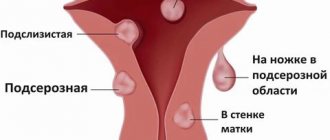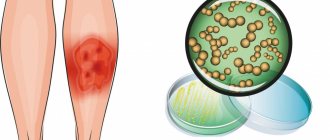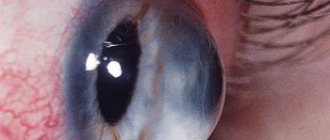Ophthalmologist, Laser ophthalmic surgery
Karapetyan
Arevik Samvelovna
7 years experience
Ophthalmologist
Make an appointment
Acute purulent inflammation in the hair follicle of the eyelash or in the sebaceous gland is called “barley” because of its characteristic round shape, reminiscent of grain. The external harmlessness of this phenomenon is deceptive: it clearly indicates a decrease in the protective properties of the immune system and requires careful treatment to prevent relapses and possible complications.
Causes of stye on the eye
Staphylococci, which prefer to settle on human skin and hair, do not manifest themselves in any way with strong immunity. Their intensive reproduction is triggered by a decrease in the protective properties of the body, its hypothermia, severe illnesses and hypovitaminosis, and the consequences of helminthic infestation. Penetrating into the structure of the hair follicle, streptococci cause inflammation and suppuration as a reaction to a pathogenic microorganism. This is the main cause of stye on the eye in patients of all ages. With an unbalanced diet, increased physical activity or stressful situations, the disease can occur in the form of several or multiple suppurations on the eyelids or mucous membranes. Also among the factors contributing to the appearance of stye on the eye is the habit of touching the eyelids with dirty hands, a large amount of dust indoors or outdoors.
The risk group for the likelihood of the appearance of barley includes:
- patients with reduced immunity;
- persons with diseases of the endocrine system;
- patients with gastrointestinal pathologies;
- persons whose professional activities involve working outdoors or in premises with difficult climatic or unsanitary conditions;
- patients who have suffered inflammatory diseases of the eyes and eyelids, as well as those who have not completed the prescribed course of treatment.
4.Prevention
A few simple tips will help prevent stye in most cases:
- Don't rub your eyes. This can irritate the eye and allow bacteria to enter the eye. If you must touch your eyes, wash your hands first.
- Protect your eyes from dust and dirty air if possible. For example, wear safety glasses during very dusty household tasks.
- Regularly (at least every 6 months) renew your eye makeup, especially mascara. This is a very favorable environment for bacterial growth.
- If you tend to get styes and chalazions frequently, wash your eyelids regularly with warm water. You can add a small amount of baby shampoo to it.
- See a doctor immediately and treat any inflammation or infection of the eyes or eyelids.
Symptoms of stye on the eye
Suppuration of the eyelid makes itself felt by a feeling of heaviness, swelling and inflammation along the eyelash line. The area becomes painful, the temperature of the skin of the eyelids rises. The line of edema has clear boundaries; signs of hyperemia are noticeable on the conjunctiva - redness and inflammation. Within 2-3 days from the moment the barley develops, a purulent head forms on its surface, the contents of which are dead cells of the hair follicle.
With internal barley, the pathology is localized in the area under the eyelid - in the so-called meibomian gland, which makes the disease almost invisible. The inflammatory process is indicated by the characteristic symptoms of stye - thickening and soreness of the affected eyelid. The danger of such a disease is the development of chalazion - inflammation of the cartilage around the meibomian gland, which significantly delays the healing process and forces the patient to undergo regular examinations by an ophthalmologist.
In severe cases, with barley localized inside the sebaceous gland, signs of general intoxication are observed - headache and muscle pain, fever, swollen lymph nodes. Self-medication in this case is strictly contraindicated, and the patient should immediately seek medical help.
Are you experiencing stye symptoms?
Only a doctor can accurately diagnose the disease. Don't delay your consultation - call
Complications of the disease
Internal stye (like external stye) can often be accompanied by inflammation of nearby lymph nodes, swelling and hyperthermia, headache and general malaise. There are cases when the inflammatory process of the meibomin glands causes purulent inflammation of the orbit, thrombophlebitis of the orbital veins, thrombosis of the cavernous sinus, inflammation of the meninges and septicemia - dangerous conditions that can lead to death. Usually, this happens when trying to squeeze pus out of an abscess, because... the blood of the eyelids flows to the veins of the orbit, and then to the sinuses of the brain.
Sometimes several styes form at once, which merge into a single abscess. In this case, the likelihood of serious complications becomes much higher.
Types and stages of development of barley
Depending on the location and external signs there are:
- External stye is a painful formation on the eyelash line that quickly festeres. Signs of barley in this case are visible to the naked eye, which simplifies the diagnosis;
- internal barley - localized inside the eyelid, causing discomfort due to severe pain and the feeling of a foreign object in the eye. It is detected during a visual medical examination.
The formation and development of barley occurs in several stages:
- infiltration process. The first characteristic signs of suppuration appear: itching, swelling, redness of the eyelid in the area of inflammation. Over the course of several hours, the discomfort intensifies;
- process of suppuration. A capsule with purulent contents is visible on the surface of the formation. With an increase in the volume of pus or mechanical impact, it may break out prematurely;
- the process of breakthrough of the purulent capsule. If the inflammation does not break out on its own, it is opened by a surgeon. Separation of purulent contents occurs within several days;
- healing. A crust forms at the site of the ulcer, under which a thin layer of restored skin forms. Depending on the quality of the course of treatment and the state of the immune system, the healing period can range from several days to several weeks.
Complications of stye on the eye
The importance of seeing a doctor when barley appears is due to the high risk of developing the following complications:
- conjunctivitis is an infectious lesion of the mucous membrane of the eye, causing swelling, hyperemia and some blurring of vision. Treatment of the disease is complex and lengthy;
- Chalazion is a cystic formation on the inside of the eyelid. Causes inconvenience and requires long-term treatment;
- phlegmon of the orbit - caused by profuse suppuration due to an attempt to independently open the stye or multiple formation of foci of suppuration with their subsequent fusion. Symptoms of this pathology are blurred vision, severe swelling, discomfort when moving the eyelid, etc.;
- thrombosis of the vascular plexus - a violation of the outflow of fluid from the orbit, which causes swelling. The eyeball protrudes, the skin turns blue, the eyelids become inflamed, and vision deteriorates sharply;
- thrombophlebitis is an inflammatory process in blood vessels. Characterized by headache, feeling of fatigue, decreased visual acuity, redness of the eye mucosa;
- meningitis - consequences of phlegmon of the eye. Signs of a deadly pathology: temperature above 39°C and severe headache;
- sepsis is blood poisoning due to the ingress of pus and pathogenic microorganisms into it. Signs of complications: intoxication of the body, chills, rapid heartbeat, rash, breathing problems.
Chalazion – what is it?
Unlike barley, a chalazion is a non-infectious inflammation that occurs due to blockage of a gland located in the thickness of the eyelid; during this process, the gland stops secreting a secretion, which stagnates and leads to the appearance of a granuloma or pea.
As a rule, a chalazion is painless, the skin over it moves easily and is not changed.
For chalazion, as for barley, there is no need to have a cause for its occurrence. But in the case of chronic inflammation of the eyelids or blepharitis, poor hygiene of the eyelids, hands, and the presence of skin diseases, for example, seborrheic dermatitis or rosacea, the likelihood of developing chalazion or stye increases significantly.
It is also worth noting the fact that smears, cultures, consultations with other specialists, and additional examinations are not needed, since the treatment tactics will not change. An ophthalmologist treats stye and chalazion!
If chalazions appear frequently, then you should understand that reduced immunity or problems with the gastrointestinal tract have nothing to do with it, just like a lack of vitamins.
Most often, the occurrence of chalazions is associated with insufficient eyelid hygiene and chronic blepharitis. Chalazions can be a reaction to laundry detergents, bathing products, etc.
Therefore, the main emphasis in the treatment of chalazion is on regular daily hygiene of the eyelids, which includes warm compresses, massage, and cleansing of the eyelash margin. If you follow all the measures and doctor’s prescriptions, remission will not take long. It is worth noting that eyelid hygiene must be observed during remission in order to reduce the risk of recurrence of formation.
Treatment of barley
With strong immunity, the disease can go away on its own without special treatment. This happens if the adverse effects on the body have stopped and the activation of staphylococcus has been suppressed.
Self-treatment of stye on the eye with medications at home is not recommended. Moreover, folk recipes often pose a threat to vision. Tips on how to treat stye can cause rupture of the purulent capsule and infection of the eye mucosa with the most serious consequences.
A course prescribed by a specialist will be many times more effective and safer. Its components are antibacterial drugs, local antibiotics and compounds for relieving the inflammatory process. Treatment of barley should be carried out under supervision and based on the recommendations of a specialist. If a complication develops, he will immediately correct the course and take measures to prevent further inflammation.
Prevention of stye
The following will help eliminate the risk of stye:
- compliance with personal hygiene rules;
- measures to strengthen the body's defenses and restore immunity;
- eliminating situations of overheating or hypothermia of the body;
- timely treatment of serious infectious diseases;
- active lifestyle;
- balanced diet, taking vitamin courses.
Additional recommendations taking into account the patient’s body condition will be given by the attending physician.
Causes of the disease
There is an opinion that the reason for the appearance of internal barley is severe hypothermia of the body, but this is not true. Hypothermia, of course, is a risk factor influencing the development of the inflammation process. And yet, inflammation of the inner eyelid is caused by a bacterial infection, and sometimes by ordinary skin mites.
The main causes of internal barley are considered to be:
- Infectious lesions;
- Weakening of the immune system;
- Allergic reactions;
- Hormonal imbalance (especially in teenagers);
- Failure to comply with hygiene rules;
- Neglecting the rules of wearing lenses;
- Hypothermia.
Stye on the inner eyelid often occurs in people with diabetes, hypovitaminosis, gastrointestinal problems (especially those suffering from constipation), as well as with weakened immunity, anemia and immunodeficiency states. Such conditions also lead to frequent relapses of internal styes, which may be accompanied by general furunculosis, blepharitis, and acne vulgaris.
Questions and answers
What causes stye on the eye?
The main cause of inflammation is infection of the sebaceous gland or hair follicle of the eyelash due to the active activity of staphylococci. This is facilitated by air pollution, a decrease in the protective properties of the immune system, and non-compliance with personal hygiene rules. Less commonly, stye appears on the eye due to difficult professional conditions or untreated infectious eye diseases.
How does stye appear?
The first signs of stye are discomfort of the eyelid, noticeable inflammation and swelling of the eyelash area, itching and a feeling of some heaviness. Within a few days, a yellow, purulent head of inflammation becomes noticeable on the surface of the skin. As it matures, it breaks through, after which a number of “inflammatory” symptoms of the disease go away, but a slight itching and an area of redness remain.
How to quickly remove stye from the eye?
Any methods of treating stye should be agreed upon with an ophthalmologist. The sooner you seek help, the faster you will be able to cope with the pathology. Antibacterial agents and topical ointments will help speed up the breakthrough of the purulent capsule. Attempts to quickly remove stye from the eye with compresses, heating or squeezing out pus are very dangerous and can cause serious inflammation of the mucous membrane and damage to the eyeball.
Prevention of eye stye
Prevention of the disease consists of simple rules, the main one of which is hygiene. Not worth it:
- leave makeup on eyelashes and eyelids overnight;
- rub your eyes, comb them;
- use someone else's brushes to apply makeup;
- overwork, hypothermia;
- neglect the rules of wearing and caring for contact lenses.
By following these recommendations, you will not protect yourself from the appearance of barley 100%, but you will significantly reduce the likelihood of its occurrence.
Stages of the disease
There are several stages in the development of the disease:
- Infiltration. A small bump appears on the inner or outer surface of the eyelid, which can easily be confused with a speck that has gotten into the eye. In this area, itching, redness, and slight swelling occur, which intensify over time.
- Suppuration. After some time, the swelling increases, fills with pus and causes serious discomfort when touched or blinked.
- Breakthrough of the abscess. In the normal course of the disease, after 3-4 days the abscess ripens and ruptures itself, the contents coming out to the surface of the skin. if this does not happen, the purulent capsule will have to be opened surgically in the doctor’s office.
- Healing. The affected area ceases to be painful, the wound heals, a crust forms, which falls off over the next few days, revealing healthy tissue.
Stye in a child
In children, due to the characteristics of the immune system and their lifestyle, this purulent disease occurs quite often. Inadequate treatment or untimely medical care can provoke eyelid abscess and other equally dangerous complications.
It is important to understand that in children under one year of age, the orbital tissue of the eyeball is especially fragile, so an ordinary stye can turn into an abscess even faster - within a few hours. Therefore, it is important to closely monitor the child’s health and, at the first suspicion of a disease, immediately contact a specialist.
Disease prevention
To prevent the development of barley, the following recommendations should be followed:
- regularly clean the surface of the eyelids;
- strengthen the immune system;
- eat foods rich in vitamins and microelements;
- eliminate alcohol consumption and smoking;
- reduce the number of stressful situations;
- establish a sleep schedule;
- Visit your ophthalmologist regularly for preventative eye examinations.
The ophthalmologist at our medical clinic has extensive experience in treating inflammatory eye diseases and will do everything necessary to effectively and quickly cope with the pathology once and for all. You can make an appointment by phone or by leaving a request on the website.
What not to do with barley
Under no circumstances try to squeeze out the abscess. Purulent contents can spread through the blood throughout the entire eye, which leads to blood poisoning, eyelid abscess and other extremely dangerous consequences.
If an abscess appears, it is also not recommended:
- rub and comb your eyes;
- perform any manipulations with dirty hands;
- apply cosmetics;
- use contact lenses;
- warm or cool the site of inflammation.
Causes of stye
- the presence of infection (most often it is Staphylococcus aureus, which is present on the skin and in the nasopharynx cavity in many people);
- a general decrease in immunity, which is possible against the background of colds, metabolic disorders, seasonal hypovitaminosis, poor nutrition, anemia and other conditions;
- neglect of personal hygiene: habit of rubbing eyes with unwashed hands, sharing towels, etc.;
- the presence of other inflammatory eye diseases - chronic blepharitis, conjunctivitis.











